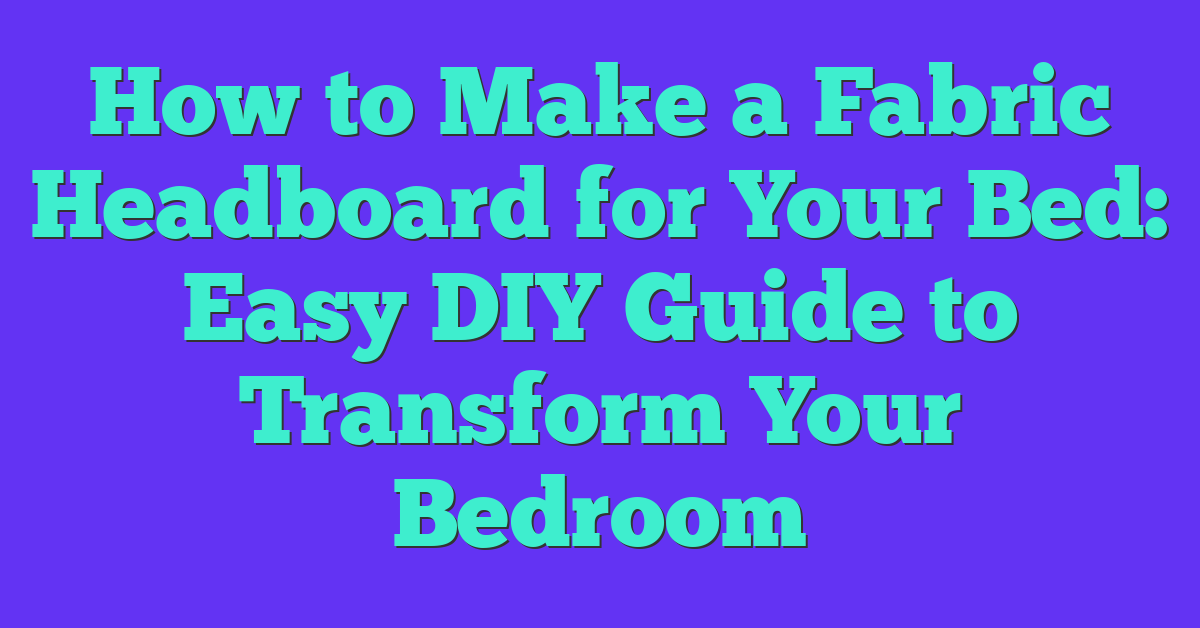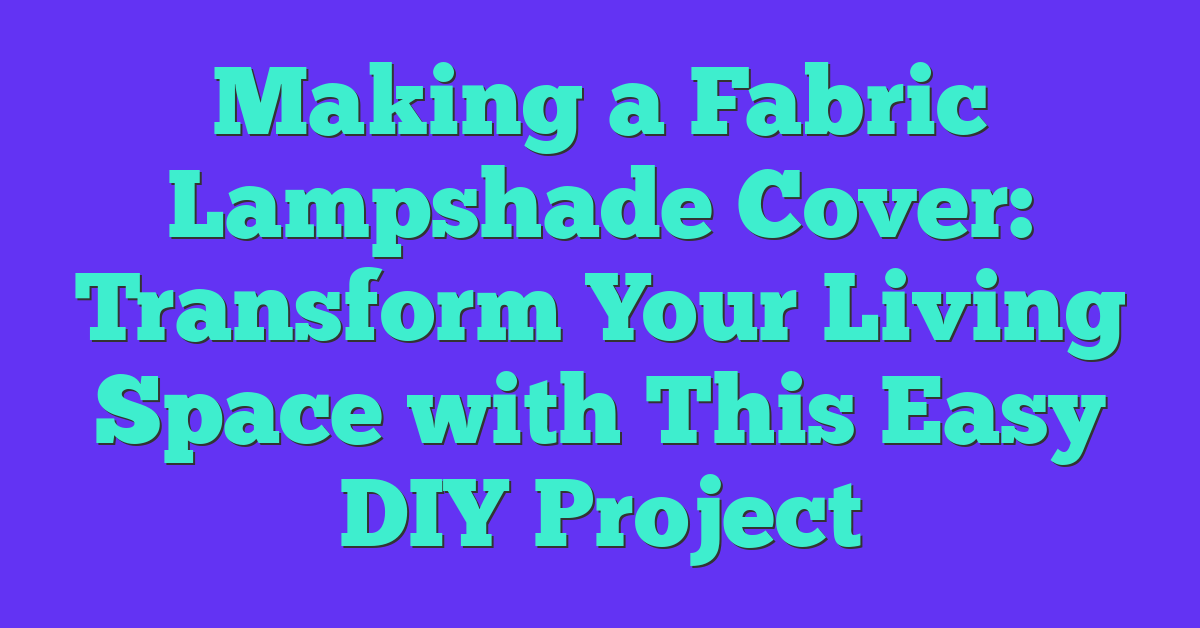There’s something about a fabric headboard that instantly makes a bedroom feel cozy and polished. I’ve always loved how it can transform the look of a bed, adding a touch of personality and charm. The best part? You don’t need to spend a fortune to get one that’s stylish and unique.
When I first decided to make my own fabric headboard, I was surprised by how simple and rewarding the process was. With just a few materials and a little creativity, you can create a custom piece that perfectly fits your style. Whether you’re going for bold patterns or soft neutrals, it’s all about making it your own.
Tools And Materials Needed
Creating a fabric headboard is straightforward with the right tools and supplies. Here’s everything I rely on to craft a custom headboard with ease.
Essential Tools
- Staple Gun: Provides a secure finish for attaching fabric. I use a heavy-duty staple gun for durability.
- Scissors: Cuts fabric cleanly. Sharp fabric scissors work best for precise edges.
- Measuring Tape: Ensures accurate dimensions. I use it repeatedly during cutting and assembly.
- Drill: Secures the headboard to the bed frame or wall when needed.
- Screwdriver: Tightens screws if brackets require manual adjustments.
Fabric Selection Tips
Choosing the right fabric defines the headboard’s visual appeal. I always consider:
- Durability: Upholstery-grade fabric lasts longer. For example, consider linen, velvet, or twill.
- Texture: Soft textures enhance coziness. I prefer chenille or suede for added depth.
- Pattern and Color: Bold prints create focus, while neutrals provide timeless charm. Match fabric to your bedroom’s color scheme for cohesion.
Other Supplies To Gather
Gather these items before beginning for a seamless process:
- Foam Padding: Adds comfort. High-density foam works well for support.
- Plywood or MDF: Forms the backboard. I choose a sturdy board measuring around 1/2 inch thick.
- Batting: Covers foam for a smoother surface. Polyester batting is lightweight and easy to handle.
- Staples: Ensure they’re compatible with the staple gun. I stock 3/8-inch staples for most projects.
- Spray Adhesive: Adheres foam to the board securely.
These supplies help me create a durable and stylish fabric headboard every time.
Preparing Your Work Area
Setting up a well-organized work area creates efficiency and minimizes distractions. A clean, spacious surface makes handling fabric and tools easier, ensuring precise results.
Choosing The Right Space
Select a flat, clutter-free surface like a large table or a hardwood floor. The area should provide enough room for cutting fabric, measuring materials, and assembling the headboard without cramping your movements. Adequate lighting is essential to clearly see fabric patterns and measurements. If using power tools such as a drill, choose a space with access to electrical outlets or room to maneuver with an extension cord.
Protecting Surfaces
Protecting your work area prevents accidental damage during cutting, stapling, or adhesive application. Place a durable drop cloth, cutting mat, or layer of newspaper over the surface. This barrier protects against scratches from scissors or drills, stray staples, and any adhesive overspray. For added assurance, tape down protective covers to keep them securely in place while working.
Step-By-Step Instructions For Making A Fabric Headboard
Crafting a fabric headboard involves simple steps that combine precision and creativity. Below, I’ll guide you through how to measure, cut, assemble, and finish your custom headboard.
Measuring And Cutting Materials
Accurate measurements are the foundation of the project. I measure the width of my bed frame to determine the headboard’s horizontal size, ensuring it matches. For height, I decide based on personal preference, typically between 20-36 inches, depending on style and bed frame height.
I mark measurements on the plywood or MDF, ensuring straight edges for a clean finish. Using a quality saw or jigsaw, I carefully cut the board. I also cut foam padding to fit, leaving an inch or two excess on all sides. Finally, I cut batting and fabric, leaving at least 4-6 inches extra on each side to wrap securely.
Assembling The Base
I ensure the board is smooth and free of splinters by sanding edges lightly. To create stability, I attach mounting hardware on the back at this stage, using a drill to secure brackets or D-rings. This step ensures the headboard hangs or attaches firmly to the bed frame later.
If rounded edges are part of the design, I shape the foam and board before moving to the next step. This adds elegance but needs precision in shaping tools.

Attaching The Foam And Batting
Adhering foam to the base makes the headboard plush. I spray adhesive lightly on the board and press the foam down evenly, starting from the center and working outward. This prevents bubbles or gaps.
Next, I drape batting over the foam. Wrapping it snugly to the back, I staple it in place using a heavy-duty staple gun. I space staples about 2-3 inches apart for security without creating tension ripples. This step ensures smooth padding beneath the fabric layer.
Wrapping And Securing The Fabric
I carefully spread the fabric over the batting, aligning patterns or textures if applicable. Starting at the center of one side, I pull the fabric taut and secure it with staples on the back of the board. I move outward from the center to ensure even tension.
When I reach the corners, I fold them neatly, tucking the fabric like wrapping a gift. I staple each fold firmly in place. After verifying the fabric is wrinkle-free, I trim excess material for a polished finish without fraying edges. Custom piping or decorative trims can be added for extra detail if desired.
Adding Finishing Touches
The finishing touches give your fabric headboard a professional and polished look. Taking care of details like edges and hardware ensures durability and style.
Trimming And Tucking Edges
Making a Fabric Lampshade Cover: Transform Your Living Space with This Easy DIY Project »
Neatly trimming and tucking edges enhances the headboard’s appearance while preventing fraying. I use sharp fabric scissors to carefully trim excess fabric along the back after stapling. For a clean result, I fold the edges inward before securing them with additional staples, keeping the folds consistent and tidy. To ensure corners look smooth, I create tight hospital-style folds, which eliminate bunching. Adding fabric glue along the tucked sections can provide extra hold if any areas feel loose.
Installing Mounting Hardware
Securing the mounting hardware determines your headboard’s stability. I select hardware based on the weight of the headboard and the type of bed frame. Using a drill, I attach evenly spaced D-rings or French cleats to the back of the plywood or MDF board. For wall-mounted headboards, I measure the placement precisely to ensure even alignment and use heavy-duty anchors. If attaching the headboard directly to the bed frame, I check the manufacturer’s recommendations for brackets or screws. Double-checking the screws’ tightness prevents wobbling over time.
Tips For Customization
Creating a fabric headboard provides endless opportunities for customization. These tips can help craft a design that complements your bedroom and reflects your style.
Adding Buttons Or Tufting
Incorporating buttons or tufting adds texture and sophistication to a fabric headboard. To create a tufted look, I recommend evenly spacing small markings on the foam to guide button placement. Use a long upholstery needle threaded with strong twine to pull the fabric and foam tightly at each mark, securing the button with a sturdy knot at the backboard. Opt for fabric-covered buttons in the same or contrasting material for a personalized touch. Tufting works well with padded headboards and gives them a plush, classic finish.
Choosing Decorative Trims
Decorative trims enhance a headboard’s edges or outline its shape. I suggest applying nailhead trim for a clean and polished appearance or using decorative braids and fringes for a softer aesthetic. To apply nailhead trim, measure and mark equal spacing along the headboard’s edge, then hammer the nails carefully to maintain a straight line. For fabric trims, use fabric glue or a staple gun to attach them smoothly. Adding trims can transform a simple headboard into an elegant centerpiece.

Matching Headboard Styles With Bedroom Decor
Coordinating the headboard with the bedroom decor ties the elements together. I like to draw inspiration from existing patterns or colors in the room, such as using neutrals for minimalist spaces or bold prints to complement expressive decor. Consider materials like linen for a casual vibe or velvet for a touch of luxury. Matching or contrasting the headboard’s fabric with curtains, bedding, or furniture accents unifies the design, ensuring harmony within the space.
Conclusion
Making a fabric headboard is such a rewarding project that lets you add a personal touch to your bedroom. There’s nothing quite like stepping back and admiring something you’ve created with your own hands. It’s not just about saving money—it’s about crafting a piece that feels uniquely yours.
Whether you go bold with vibrant patterns or keep it soft with neutral tones, the options are endless. Don’t be afraid to experiment and let your creativity shine. Your bedroom deserves a centerpiece that reflects your style, and a custom fabric headboard is the perfect way to achieve that.

















